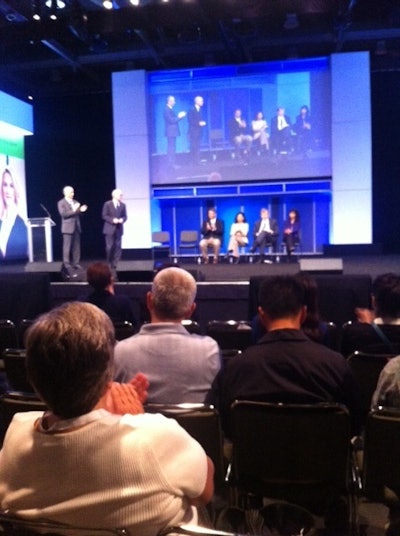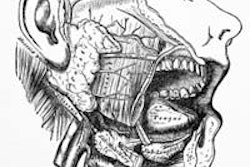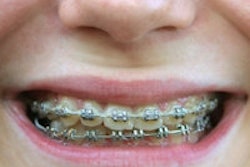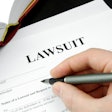
SAN FRANCISCO - Osteonecrosis of the jaw (ONJ) often befuddles dentists in their daily practice because so many unanswered questions surrounding it remain.
An expert panel moderated by Michael Glick, DMD, and Dan Meyers, DDS, sought to tackle some of these questions during a morning session today in one of the largest auditoriums in the Moscone Center at the 2012 ADA Annual Session.
The expert panel consisted of Thomas Dodson, DMD, MPH, and Sook-Bin Woo, DMD, MMSc, both from the Harvard School of Dental Medicine; Cesar Migliorati, DDS, PhD, from the University of Tennessee Health Science Center; and Joan Otomo-Corgel, DDS, MPH, from the University of California, Los Angeles School of Dentistry.
 An expert panel discussed the issue of osteonecrosis of the jaw during a presentation on Friday at the 2012 ADA Annual Session.
An expert panel discussed the issue of osteonecrosis of the jaw during a presentation on Friday at the 2012 ADA Annual Session.Dr. Migliorati opened the session, emphasizing that the condition can no longer be called just bisphosphonate-associated ONJ because research has shown that other drugs also play a role in its development.
He did start his lecture with a look at bisphosphonate patients who had been treated for cancer. He explained how these patients would develop an exposed necrotic bone after an extraction and there would be no healing. Once these patients were followed, it was discovered that they were taking a medication that was suppressing bone remodeling and that is why there was no healing.
But today things are different, he said.
Dr. Migliorati defined the condition currently as the presence of necrotic bone, exposed or not, anywhere in the oral cavity in a patient taking a drug associated with osteonecrosis.
He then showed an image of two patients, one of whom was exfoliating the entire mandible, while the other had some changes around the canine and the premolar was not healing from the extraction, but there was no exposed bone.
Dr. Migliorati pointed out that they were both breast cancer patients who had been treated with zoledronic acid, but both showed different presentations of the condition.
"It can range from very simple to very severe," he said. "The problem is we cannot tell which patient is going to respond in which way."
Dr. Migliorati said that it is extremely important to take at-risk patients' medical history in these kinds of situations and ask specific questions. An osteoporosis patient may have received one zoledronic injection in a year, and may not remember and inform their dentist about it, but it is the dentist's responsibility to ask.
"If you have a patient with osteoporosis or cancer you, have to address the possibility that they may have been taking this medication and may be at risk," he emphasized.
The discussion with the patient should include questions about pain, discomfort, and mouth odor. For the clinical evaluation, dentists can look for exposed necrotic bone or not. They may just find only a fistula, draining puss, some discomfort but no visible necrotic bone, Dr. Migliorati explained.
Next, the practitioner should look at a radiograph. He used the example of a prostate cancer patient who was referred to him for extraction because he was going to receive radiation treatment. The patient had osteonecrosis of the jaw, and Dr. Migliorati made the diagnosis. Clinically, the patient had no exposed bone, only fistulas and draining puss, but radiographically he had an extensive area of bone involvement.
"ONJ is no longer just about exposed necrotic bone -- patients who have no exposed bone can also have ONJ," he said.
Another point Dr. Migliorati emphasized was that this is no longer only a bisphosphonate-related problem. New drugs can have similar effects; for example, antiangiogenics that are used on solid tumors also can be involved with some patients developing ONJ, he explained.
"Open up your mind," he said. "This is no longer just a problem with just bisphosphonates."
In general, patients with cancer are at a higher risk because they take medication at a higher dose, but patients with osteoporosis also are at risk, although their risk is lower. Also, cumulative dosing is important, since the longer a patient takes the medication, the higher the risk is for the person.
In his closing remarks, Dr. Migliorati emphasized that dentists should evaluate patients individually, assess each patient's risk, and discuss that risk based on their own knowledge. If the dentist is not comfortable treating the patient and feels it is outside his or her area of expertise, it is best to refer.
"Never let them go without doing anything to help them just because they have been taking this medication," he concluded.



















